新版人教版七年级英语上教案完整版
- 格式:docx
- 大小:295.17 KB
- 文档页数:76

人教版初一英语上册教案15篇人教版初一英语上册教案【篇1】教学年级:七年级课程名称:Unit 3 Why do you like koalas?教材版本:人民教育出版社授课时间:40分钟(一)学生分析:1.本班学生对学习英语较感兴趣,能积极参加各种调查、采访、表演等实践活动。
2.学生学习动机明确,学习态度积极主动,能主动与他人合作,相互帮助,共同完成学习任务,遇到问题敢于主动向老师和同学请教,能大胆用英语交流。
(二)教材分析:本课时的内容是义务教育课程标准实验教科书英语新目标“Go for it!”七年级的《Unit 3 Why do you like koalas?》第一课时,主要话题是学习动物名称,并讨论喜好某种动物的原因。
通过话题的讨论喜欢动物的原因,增强了动物名称的词汇量,还增强课堂学习趣味性。
(三)教学目标语言知识目标1.学习有关动物的名词:tiger elephant koala dolphin panda lion penguin giraffe2.学习并运用品质的.形容词:cute smart shy ugly clever beautiful friendly quiet lazy来描述动物.3.掌握下列句型Why do you like…?. Because they’re….使学生熟练表达喜好并陈述原因。
语言能力目标1.学生能熟练谈论自己喜爱的动物并给出理由。
2.学生的口语和书面表达能力得到提高。
3.培养学生主动参与语言实践活动的能力,在游戏和小组竞赛中培养学生乐于表达、勇于展示自我的能力,从而树立学习英语的信心,获取成功的喜悦。
情感目标1.通过学习要培养学生自觉保护动物的意识。
2.培养学生积极参与,发扬团队合作的精神和竞争意识。
(四)教学策略1、教学方法Task-based, Language Teaching,途径:Guesing game, group work, pair work, survey, Internet teaching.2、教学辅助手段采用多媒体电脑投影图片,充分利用网络教材资源,扩大学生的知识面,激发学生的兴趣和求知欲。
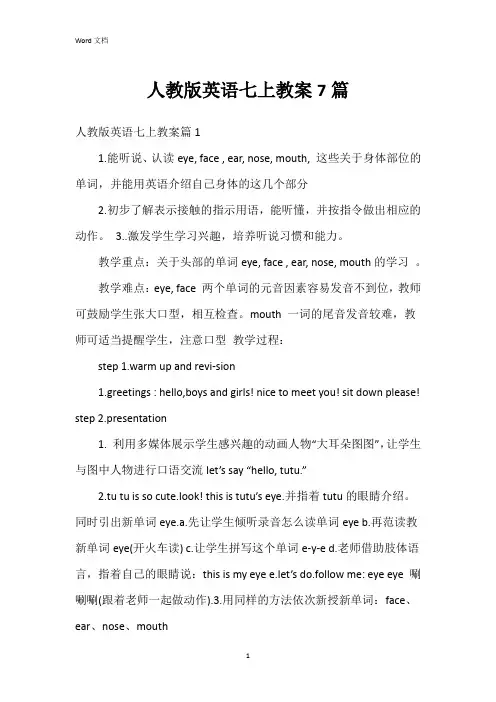
人教版英语七上教案7篇人教版英语七上教案篇11.能听说、认读eye, face , ear, nose, mouth, 这些关于身体部位的单词,并能用英语介绍自己身体的这几个部分2.初步了解表示接触的指示用语,能听懂,并按指令做出相应的动作。
3..激发学生学习兴趣,培养听说习惯和能力。
教学重点:关于头部的单词eye, face , ear, nose, mouth的学习。
教学难点:eye, face 两个单词的元音因素容易发音不到位,教师可鼓励学生张大口型,相互检查。
mouth 一词的尾音发音较难,教师可适当提醒学生,注意口型教学过程:step 1.warm up and revi-sion1.greetings : hello,boys and girls! nice to meet you! sit down please! step2.presentation1. 利用多媒体展示学生感兴趣的动画人物“大耳朵图图”,让学生与图中人物进行口语交流let’s say “hello, tutu.”2.tu tu is so cute.look! this is tutu’s eye.并指着tutu的眼睛介绍。
同时引出新单词eye.a.先让学生倾听录音怎么读单词eye b.再范读教新单词eye(开火车读) c.让学生拼写这个单词e-y-e d.老师借助肢体语言,指着自己的眼睛说:this is my eye e.let’s do.follow me: eye eye 唰唰唰(跟着老师一起做动作).3.用同样的方法依次新授新单词:face、ear、nose、mouth4.powerpoint制作:打开幻灯片后每点击一身体部位就会出现相应的单词。
(注mouth一词的尾音发音较难,适当提醒学生,注意口型。
)5.认读face、ear、eye、nose、mouth的单词卡片和图片。
step3:practice1.let’s do: eye eye 唰唰唰ear ear 呼呼呼nose nose 闻闻闻mouth mouth 巴巴巴face face 拍拍拍2.i say you do.(老师说,学生快速做相应的动作,然后找一位学生出来做出动作。
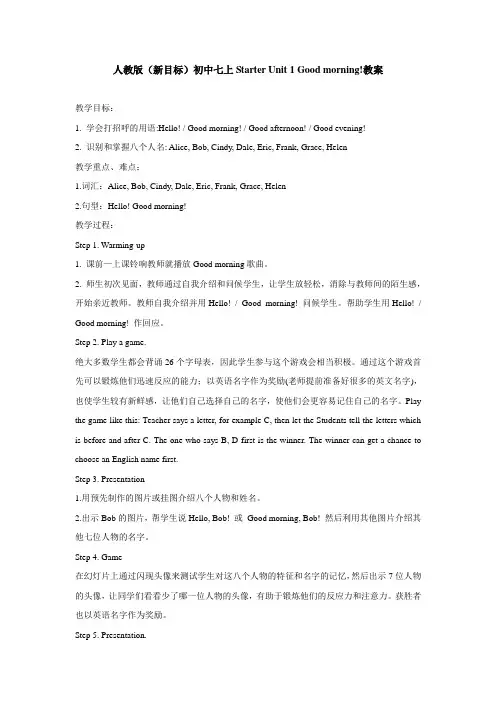
人教版(新目标)初中七上Starter Unit 1 Good morning!教案教学目标:1. 学会打招呼的用语:Hello! / Good morning! / Good afternoon! / Good evening!2. 识别和掌握八个人名: Alice, Bob, Cindy, Dale, Eric, Frank, Grace, Helen教学重点、难点:1.词汇:Alice, Bob, Cindy, Dale, Eric, Frank, Grace, Helen2.句型:Hello! Good morning!教学过程:Step 1. Warming-up1. 课前—上课铃响教师就播放Good morning歌曲。
2. 师生初次见面,教师通过自我介绍和问候学生,让学生放轻松,消除与教师间的陌生感,开始亲近教师。
教师自我介绍并用Hello! / Good morning! 问候学生。
帮助学生用Hello! / Good morning! 作回应。
Step 2. Play a game.绝大多数学生都会背诵26个字母表,因此学生参与这个游戏会相当积极。
通过这个游戏首先可以锻炼他们迅速反应的能力;以英语名字作为奖励(老师提前准备好很多的英文名字),也使学生较有新鲜感,让他们自己选择自己的名字,使他们会更容易记住自己的名字。
Play the game like this: Teacher says a letter, for example C, then let the Students tell the letters which is before and after C. The one who says B, D first is the winner. The winner can get a chance to choose an English name first.Step 3. Presentation1.用预先制作的图片或挂图介绍八个人物和姓名。
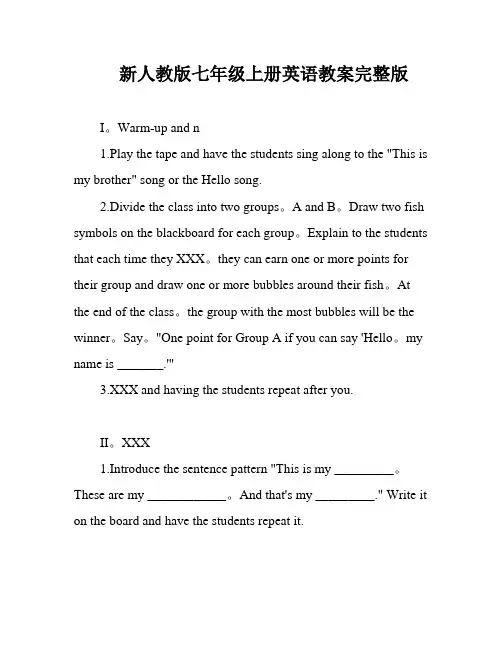
新人教版七年级上册英语教案完整版I。
Warm-up and n1.Play the tape and have the students sing along to the "This is my brother" song or the Hello song.2.Divide the class into two groups。
A and B。
Draw two fish symbols on the blackboard for each group。
Explain to the students that each time they XXX。
they can earn one or more points for their group and draw one or more bubbles around their fish。
At the end of the class。
the group with the most bubbles will be the winner。
Say。
"One point for Group A if you can say 'Hello。
my name is _______.'"3.XXX and having the students repeat after you.II。
XXX1.Introduce the sentence pattern "This is my _________。
These are my ____________。
And that's my _________." Write it on the board and have the students repeat it.2.Show a picture of a family and model the sentence pattern using the family members in the picture。

七年级上册英语教案人教版免费(经典版)编制人:__________________审核人:__________________审批人:__________________编制单位:__________________编制时间:____年____月____日序言下载提示:该文档是本店铺精心编制而成的,希望大家下载后,能够帮助大家解决实际问题。
文档下载后可定制修改,请根据实际需要进行调整和使用,谢谢!并且,本店铺为大家提供各种类型的经典范文,如工作总结、述职报告、策划方案、演讲致辞、合同协议、条据文书、教案资料、好词好句、作文大全、其他范文等等,想了解不同范文格式和写法,敬请关注!Download tips: This document is carefully compiled by this editor. I hope that after you download it, it can help you solve practical problems. The document can be customized and modified after downloading, please adjust and use it according to actual needs, thank you!Moreover, our store provides various types of classic sample essays for everyone, such as work summaries, job reports, planning plans, speeches, contract agreements, doctrinal documents, lesson plans, good words and sentences, complete essays, and other sample essays. If you want to learn about different sample formats and writing methods, please pay attention!七年级上册英语教案人教版免费最新七年级上册英语教案人教版免费(8篇)作为一位不辞辛劳的人·民教师,通常会被要求编写教案,那么关于七年级上册英语教案怎么写呢?以下是本店铺准备的一些七年级上册英语教案人教版免费,仅供参考。
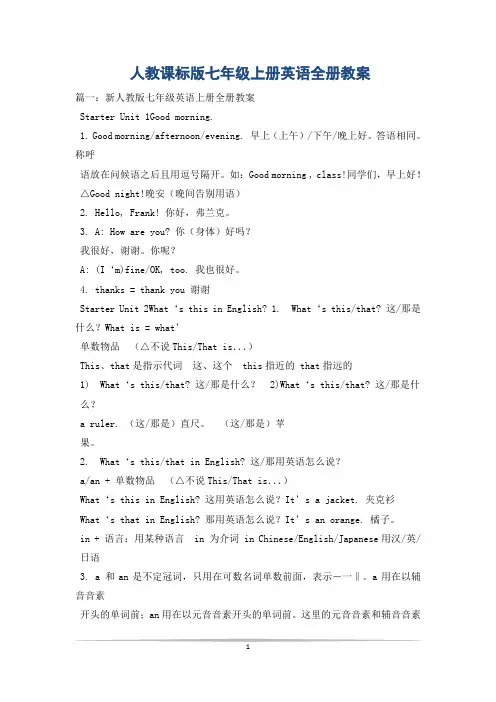
人教课标版七年级上册英语全册教案篇一:新人教版七年级英语上册全册教案Starter Unit 1Good morning.1. Good morning/afternoon/evening. 早上(上午)/下午/晚上好。
答语相同。
称呼语放在问候语之后且用逗号隔开。
如:Good morning , class!同学们,早上好!△Good night!晚安(晚间告别用语)2. Hello, Frank! 你好,弗兰克。
3. A: How are you? 你(身体)好吗?我很好,谢谢。
你呢?A: (I‘m)fine/OK, too. 我也很好。
4. thanks = thank you 谢谢Starter Unit 2What‘s this in English? 1. What‘s this/that? 这/那是什么?What is = what’单数物品(△不说This/That is...)This、that是指示代词这、这个 this指近的 that指远的1) What‘s this/that? 这/那是什么? 2)What‘s this/that? 这/那是什么?a ruler. (这/那是)直尺。
(这/那是)苹果。
2. What‘s this/that in English? 这/那用英语怎么说?a/an + 单数物品(△不说This/That is...)What‘s this in English? 这用英语怎么说?It’s a jacket. 夹克衫What‘s that in English? 那用英语怎么说?It’s an orange. 橘子。
in + 语言:用某种语言 in 为介词 in Chinese/English/Japanese用汉/英/ 日语3. a 和an是不定冠词,只用在可数名词单数前面,表示―一‖。
a用在以辅音音素开头的单词前;an用在以元音音素开头的单词前。
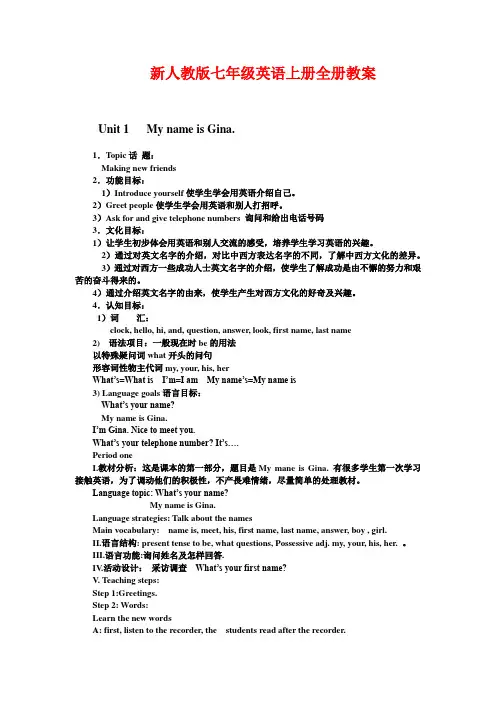
新人教版七年级英语上册全册教案Unit 1 My name is Gina.1.Topic话题:Making new friends2.功能目标:1)Introduce yourself使学生学会用英语介绍自己。
2)Greet people使学生学会用英语和别人打招呼。
3)Ask for and give telephone numbers 询问和给出电话号码3.文化目标:1)让学生初步体会用英语和别人交流的感受,培养学生学习英语的兴趣。
2)通过对英文名字的介绍,对比中西方表达名字的不同,了解中西方文化的差异。
3)通过对西方一些成功人士英文名字的介绍,使学生了解成功是由不懈的努力和艰苦的奋斗得来的。
4)通过介绍英文名字的由来,使学生产生对西方文化的好奇及兴趣。
4.认知目标:1)词汇:clock, hello, hi, and, question, answer, look, first name, last name2) 语法项目:一般现在时be的用法以特殊疑问词what开头的问句形容词性物主代词my, your, his, herWhat‘s=What is I‘m=I am My name‘s=My name is3) Language goals语言目标:What‘s your name?My name is Gina.I‘m Gina. Nice to meet you.What‘s your telephone number? It‘s….Period oneI.教材分析:这是课本的第一部分,题目是My mane is Gina. 有很多学生第一次学习接触英语,为了调动他们的积极性,不产畏难情绪,尽量简单的处理教材。
Language topic: What‘s your name?My name is Gina.Language strategies: Talk about the namesMain vocabulary: name is, meet, his, first name, last name, answer, boy , girl.II.语言结构: present tense to be, what questions, Possessive adj. my, your, his, her. 。
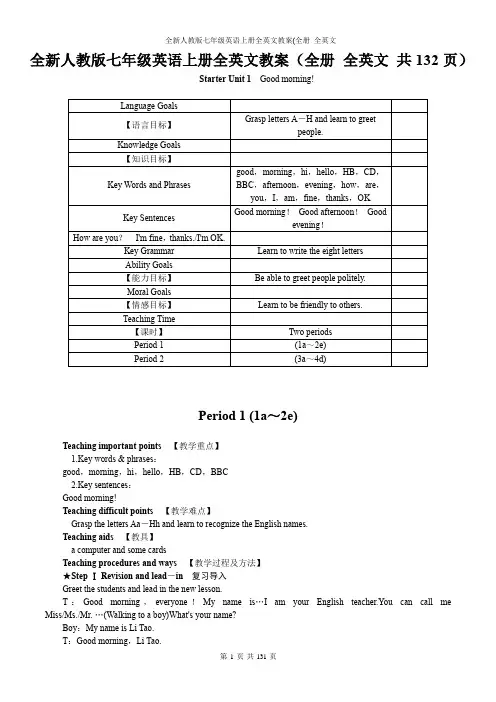
全新人教版七年级英语上册全英文教案(全册全英文全新人教版七年级英语上册全英文教案(全册全英文共132页)Starter Unit 1Good morning!Period 1 (1a~2e)Teaching important points【教学重点】1.Key words & phrases:good,morning,hi,hello,HB,CD,BBC2.Key sentences:Good morning!Teaching difficult points【教学难点】Grasp the letters Aa-Hh and learn to recognize the English names.Teaching aids【教具】a computer and some cardsTeaching procedures and ways【教学过程及方法】★Step Ⅰ Revision and lead-in复习导入Greet the students and lead in the new lesson.T:Good morning,everyone!My name is…I am your English teacher.You can call me Miss/Ms./Mr. …(Walking to a boy)What's your name?Boy:My name is Li Tao.T:Good morning,Li Tao.Boy:Good morning,Ms./Mr. …(Help the student to respond correctly if necessary.)The teacher writes “Good morning,Li Tao.”on the blackboard.★Step Ⅱ Self-studying and guiding自学指导Self-study guide 1:Self-study the new words and English names:good,morning,hi,hello,Alice,Bob,Cindy,Dale,Eric,Frank,Grace,Helen.Learn to pronounce them according to the phonetic symbols(音标).And you can listen to the tapes to help you pronounce them correctly or ask others for help.Self-study guide 2:Try reading the sentences in 1a and try to tell boys' names from girls' names.Self-study guide 3:Self-study 2c and learn to write the eight letters.Questions for thinking:1.Do you know how to greet people in the morning?2.Do you know how to write the eight letters Aa,Bb,Cc,Dd,Ee,Ff,Gg,Hh?The teacher walks around the classroom to watch and help the students study while the students are self-studying.Time for questions:Discuss the writing of the eight letters.★Step Ⅲ Check up检查核对Check up 1:Words teaching:Ask a few students to read the new words and help them correct the mistakes in pronunciation if necessary.Check up 2:Ask some students to make a conversation with their partner and see if they can respond correctly.And ask students to fill in the blanks:Boys' names:________________________________________________________________________ Girls' names:________________________________________________________________________Check up 3:Write the small letters for these big letters:A____B____C____D____E____F____G____H____★Step Ⅳ Cooperative inquiry合作探究1.Listening (1b)Play the recording of 1a,students listen and repeat.2.Pair workPractice the conversations in the picture and then greet your partner.(1c)Sample:A:Good morning,Zhang Wen!/Hello,Zhang Wen!B:Good morning,Li Yan!/Hello,Li Yan!3.Act outAsk some pairs of students to act out their dialogs in front of the class.4.Finish 2a and 2b.5.Discussion (2e)Talk about what these letters HB,CD,BBC mean.★Step Ⅴ Practice练习Write the missing big letter or small letter for each pair.(2d)★Step Ⅵ Test测试Choose the best answer.()1.书写英文字母时,占三格的是________。
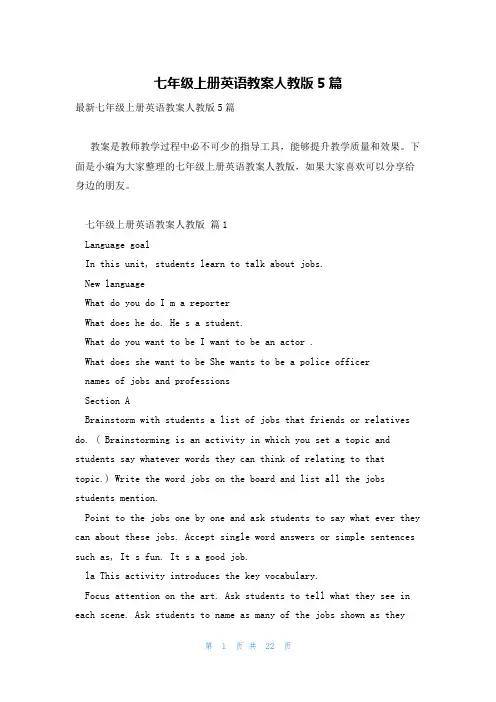
七年级上册英语教案人教版5篇最新七年级上册英语教案人教版5篇教案是教师教学过程中必不可少的指导工具,能够提升教学质量和效果。
下面是小编为大家整理的七年级上册英语教案人教版,如果大家喜欢可以分享给身边的朋友。
七年级上册英语教案人教版篇1Language goalIn this unit, students learn to talk about jobs.New languageWhat do you do I m a reporterWhat does he do. He s a student.What do you want to be I want to be an actor .What does she want to be She wants to be a police officernames of jobs and professionsSection ABrainstorm with students a list of jobs that friends or relatives do. ( Brainstorming is an activity in which you set a topic and students say whatever words they can think of relating to that topic.) Write the word jobs on the board and list all the jobs students mention.Point to the jobs one by one and ask students to say what ever they can about these jobs. Accept single word answers or simple sentences such as, It s fun. It s a good job.la This activity introduces the key vocabulary.Focus attention on the art. Ask students to tell what they see in each scene. Ask students to name as many of the jobs shown as theycan. Then point to a scene, name the job, and ask students to repeat. Point to the numbered list of words. Say each one and ask students to repeat.Then ask students to match each word wllfa one of the scenes. Say, Write the letter of each scene next to one of the ivords. Point tothe sample answer.1 b This activity gives students practice in understanding thetarget language in spoken conversation.Point to the different people shown in the picture.Ask various students to tell what they do as you point to each one,Say, Now you will hear three conversations. The conversations are about three of the people in this picture.Play the recording the first time. Students only listen.Play the recording a second time. This time ask students to write a number 1 next to the person being talked about in conversation 1. Have students put a 2 and 3 next to the people being talked about in conversations 2 and 3.Correct the answers.1 c This activity provides guided oral practice using the target language-Ask a student to read the example conversation with you. Hold upthe book and point to the doctor in the picture.Say, Now work with your partner. Make your own conversations about the picture. You can use sentences like the ones in activity 1b.Say a dialogue with a student. Point to a picture of one of the people. Guide the student to answer using one of the words inactivity 1a.As students work in pairs, move around the room monitoring theirwork. Oner language or pronunciation support as needed.2a This activity gives students practice in understanding thetarget language in spoken conversation.Ask students to look at the three pictures. Ask different students to tell you what they sec in each picture. What are the people doing What jobs do they havePlay the recording the first time. Students only listen.Say, You will hear conversations about the people in these pictures.Play the recording a second time. Say, Write the number of each conversation below the picture of the person being talked about.Correct the answers.2b This activity gives students practice in understanding thetarget language in spoken conversation.Point to the three headings in the chart and read the headings to the class. Ask students, What does wants to be mean (It is not the Job the person lias now. It is the job the person wants in the future.)Play the recording the first time. Students only listen.Say, You wiU hear about the people in these pictures. You will hear the job they haw now and the job they want in the future.Play the recording a second time. This time ask students to fill in the blanks with the jobs the people have now and the ones they wantin the future. Point out the sample2c This activity provides guided oral practice using the target language.Point out the pictures in activity 2a. Ask who each person is. (They are Susan s brother. Anna s mother, and Tony s father.)Say, Now work with your partner. Ask and answer questions about thepictures. Ask, What does he or she do Then ask, What does he or she want to beSay a dialogue with a student. Point to Anna s mother and then to the example in the speech balloons. Practice the dialogue with a student.As students work In pairs, move around the room monitoring their work. Offer language support as needed.3a This activity introduces the names for the places where people work, and gives reading practice using the target language.Call attention to the pictures. Ask students to read the name for each place. As they name each place, write the word on the board and-ask the class to repeat it.Point out the list of jobs with the numbers next to each. Then call attention to the people in the pictures and the speech bubbles. Point out the sample answer and have a student read out the speech bubble. Ask students to work alone. Say, Write the number of each job in the square next to each workplace.Check the answers.3b This activity provides guided oral practice using the target language.Point out the pictures in activity 3a. Ask students to name the workplace shown In each picture.Then point out the conversation in the speech bubbles. Ask two students to read It to the class.Say, Wow work with a partner. First practice the conversation in the picture. Then make new conversations. Use jobs and places from activity 3a.Say a dialogue with a student. Point to the word waiter in activity3a and then to the picture of the restaurant. Ask a student. Where does he work Guide the student to answer using the correct place: He works in a restaurant.Then ask. What does he do and guide the student to answer, He s a waiter.As students work in pairs, move around the room monitoring their work. Offer language support as needed.4 This activity provides listening and speaking practice using the target language.Call attention to the pictures in the book showing how to play the game. Say, You will draw a picture of someone working. Other students will ask questions about the kind of job you are drawing. After two questions someone can try to guess the job.Demonstrate by drawing a picture on the board of a stick figure reporter. Add details (microphone, notebook,etc.) until students guess what job it is.Ask a student to go to the board. Say, Draw a picture of a person working. If necessary, help the student add details that show the job the person is doing. He or she can add a bank interior to show that the person is a bank clerk. A student could also use an eye chart on the wall to show that the place is a doctor s office and the personis a doctor.Ask two different students to ask questions about the Job, and then ask a third student to guess what job it is.Play the game using drawings by several different students.Alternative: If you do not want students to move from their seats, then you can ask them to do this activity sitting down in groups of four. They will need pieces of paper on which to draw their pictures. They will also need pencils.Section BNew languageWords that describe jobs, such as exciting, dangerous,boring, difficult, busy, funAdditional materials to bring to class:help wanted ads from an English-language newspaper1 a This activity introduces the key vocabulary.Focus attention on the six pictures. Ask, What job does the person have Where does the person ivnrkPoint out the numbered list of words. Say each one and ask students to repeat. Then use simple explanations and short sample sentences to help students understand what each word means. For example, Exciting means very interesting and very fast-moving. A police officer has an exciting job. The job is always changing. Something is always happening. For dangerous you might say, Dangerous means not safe. You might be hurt or killed in a dangerous job.Then ask students to match each word with one of the pictures. Say, Write the letter of each picture next to one of the words. Point out the sample answer.Check the answers.1 b This activity provides guided oral practice using the target language.Call attention to the picture In this activity and ask a student to read the statement to the class. Then point to the picture of the police officer and say. It s an exciting job. Ask the class to repeat. Then say, What else can you say about being a police officer Someone may answer, It s a dangerous job. Ask the class to repeat each correct answer.Then ask students to work in pairs. Suggest that they each point to the pictures of the workers and make statements about them. As students practice, move around the classroom monitoring their work.1 c This activity provides an opportunity for oral practice.Say, Name some of the jobs from this unit. Write this list of jobs on the board. Say, Can you name some other jobs Add any new jobs to the list.Ask some students to make statements about Jobs on the list using the words in activity la. You may wish to write some of the sentences on the board so that students can copy the sentences into their notebooks.2a This activity provides listening and writing practice with the target language.Call attention to the two headings and ask a student to read die headings to the class.Point out the blank lines where students will write the name of a job (under the words wants to be).Play Ihe recording the first time. Students only listen.Say, Now I will play the tape again. This time write the name of a job under the words wants to be.2b This activity provides listening and writing practice with the target language,Call attention to the second heading and ask a student to read it to the class. Say, This time you will unite why each person wants the job.Play the recording again. Students only listen.Then say, Now I will play the tape again. This time write the reason the person wants the job under the word WhyPlay the recording. Students write their answers.Check the answers.2C This activity provides open-ended oral practice using the target language.Say, What do you want to be What words describe each job Help the class make up a list of jobs they might like to do. As students suggest possible jobs, ask the class to suggest words to describe them. Use a bilingual dictionary, if necessary, to find the names of jobs and words to describe each one.Then ask students to work in small groups. They tell each otherwhat they want to do and why. Encourage students to use dictionariesif necessary. Move from group to group offering assistance as needed. Ask individual students to tell the class about what they want tobe and why.3a This activity provides reading and writing practice using the target language.Call attention to the three newspaper ads and read these ads to the class. Say blank each time you come to a blank line.Then read each ad again separately, pausing to allow students toask questions about anything they don t understand. For example, in the first ad, students may not know that working late means workingat night. To work hard means to use a lot of energy to do the job.Ask students to fill In (he blanks in the ads using the words actor, reporter, and waiter.Check the answers.3b This activity provides reading and writing practice using the target language.Call attention to the newspaper ad and ask a student to read it,saying blank for each blank line.Ask students to fill in the blanks using words from This section. Say,Look at the pictures next to each blank line. The pictures will help you guess the correct word.Suggest that they look at the names of jobs and the words that describe jobs in the first part of Section B.Check the answers,3c This activity provides writing practice using the targetlanguage.Point out the blank strip of newspaper where students can write their own ads.Ask one or two students, What are you going to write about Repeat each of the students sentences and ask the class to repeat the sentences after you. For example: Do ^OM want an interesting but dangerous job Do you want to meet new people We need a police officer.Call the Smithtown Police Station at 555-2323.Ask students to read their ads to a partner. Ask the pairs to correct each other s work.4 This activity provides guided oral practice using thetarget language.Ask two students to read the conversation in the speech bubbles. Answer any questions students may have about it.Then say, New please work in groups. Ask efuestions to find out what jobs each person wrote about. You can use sentences like the ones we just read.As students ask questions, move from group to group. Rephrase any incomplete or incorrect questions.Also rephrase any inaccurate answers.七年级上册英语教案人教版篇2Unit 3 Language in use课型 Revision and application教材分析 Unit 3 对“自我介绍和获取信息”的功能句式进行综合训练:谈论自己或朋友的情况(活动1);根据提示完成介绍图片中人物情况的句子;填表、匹配复习表示国家、民族及人物活动的词汇。

人教版7上英语教案5篇(实用版)编制人:__审核人:__审批人:__编制单位:__编制时间:__年__月__日序言下载提示:该文档是本店铺精心编制而成的,希望大家下载后,能够帮助大家解决实际问题。
文档下载后可定制修改,请根据实际需要进行调整和使用,谢谢!并且,本店铺为大家提供各种类型的实用资料,如工作计划、汇报材料、心得体会、发言稿、合同大全、申请书、演讲稿、作文大全、教案大全、其他资料等等,想了解不同资料格式和写法,敬请关注!Download tips: This document is carefully compiled by this editor.I hope that after you download it, it can help you solve practical problems. The document can be customized and modified after downloading, please adjust and use it according to actual needs, thank you!Moreover, our store provides various types of practical materials for everyone, such as work plans, presentation materials, reflections, speech drafts, contract summaries, application forms, speech drafts, essay summaries, lesson plans, and other materials. If you want to learn about different data formats and writing methods, please stay tuned!人教版7上英语教案5篇教案的实施需要教师具备良好的组织和管理能力,以确保教学过程的顺利进行,编写详细的教案可以帮助我们更好地运用各种教学方法和策略,提高教学的多样性,以下是本店铺精心为您推荐的人教版7上英语教案5篇,供大家参考。
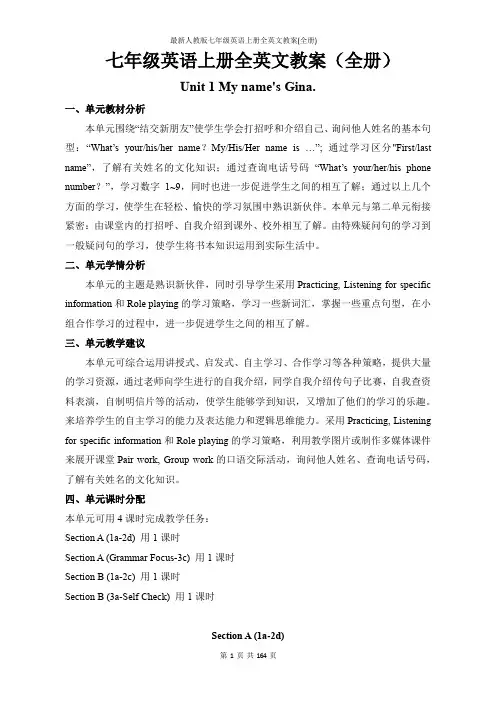
七年级英语上册全英文教案(全册)Unit 1 My name's Gina.一、单元教材分析本单元围绕“结交新朋友”使学生学会打招呼和介绍自己、询问他人姓名的基本句型:“What’s your/his/her name?My/His/Her name is …”; 通过学习区分"First/last name”,了解有关姓名的文化知识;通过查询电话号码“What’s your/her/his phone number?”,学习数字1~9,同时也进一步促进学生之间的相互了解;通过以上几个方面的学习,使学生在轻松、愉快的学习氛围中熟识新伙伴。
本单元与第二单元衔接紧密:由课堂内的打招呼、自我介绍到课外、校外相互了解。
由特殊疑问句的学习到一般疑问句的学习,使学生将书本知识运用到实际生活中。
二、单元学情分析本单元的主题是熟识新伙伴,同时引导学生采用Practicing, Listening for specific information和Role playing的学习策略,学习一些新词汇,掌握一些重点句型,在小组合作学习的过程中,进一步促进学生之间的相互了解。
三、单元教学建议本单元可综合运用讲授式、启发式、自主学习、合作学习等各种策略,提供大量的学习资源,通过老师向学生进行的自我介绍,同学自我介绍传句子比赛,自我查资料表演,自制明信片等的活动,使学生能够学到知识,又增加了他们的学习的乐趣。
来培养学生的自主学习的能力及表达能力和逻辑思维能力。
采用Practicing, Listening for specific information和Role playing的学习策略,利用教学图片或制作多媒体课件来展开课堂Pair work, Group work的口语交际活动,询问他人姓名、查询电话号码,了解有关姓名的文化知识。
四、单元课时分配本单元可用4课时完成教学任务:Section A (1a-2d) 用1课时Section A (Grammar Focus-3c) 用1课时Section B (1a-2c) 用1课时Section B (3a-Self Check) 用1课时Section A (1a-2d)一、教学目标:1. 语言知识目标:1) 能掌握以下单词:name nice meet his and her your能掌握以下句型:① —Hi. My name’s Gina. —I’m Jenny. Nice to meet you!① —What’s your/his/her name? —My/his her name is…① —Are you…? —Yes, I am. / No, I'm not.① —Is he/she…? —Yes, she/he is. / No, she/he isn’t.2) 能了解以下语法:your, his, her等形容词性物主代词的简单用法;What’s=what is I’m=I am name’s=name is等缩写形式。
人教版七年级上册英语教案16篇人教版七年级上册英语教案(精选篇1)一、复习指导思想新授课结束后,期末考试前,指导学生进行期末复习,主要复习基础知识,提高做题能力,训练阅读、听力与写作,使学生能够举一反三,熟练掌握知识点与考点.二、学生学习水平现状分析学生的主要问题是基础薄弱,做题能力参差不齐,优秀的学生不多,成绩有待于提高的学生比较多,一部分同学学习惰性强。
三、复习时间:十七周至十八周(共10课时)四、复习重点1、基础知识:unit1—unit8:重点词汇、短语、句型2、语法:(1)动词不定式(2)动名词(3)被动语态(4)形容词相关句型的运用(5)副词的运用(6)原因状语从句(7)过去进行时3、阅读训练(报纸阅读材料)4、听力(报纸、导学案套题听力训练)5、话题写作:肢体语言,义务工作,传统技艺,卡通漫画、动物保护、动物描写、未来生活畅想6、复习中注重讲练结合,及时反馈,及时检测五、课时安排时间为两周,具体计划如下:十七周(周一)unit1、2重点词组句型小结;语法训练(报纸2、3版)十七周(周二)unit1、2知识点练习,话题写作训练(报纸4版)十七周(周三)unit3、4重点词组句型小结;语法训练(报纸5、6版)十七周(周四)unit3、4知识点练习,话题写作训练(报纸7版)十七周(周五)unit5、6重点词组句型小结;语法训练(报纸8、9版)十八周(周一)unit5、6知识点练习,话题写作训练(报纸10版)十八周(周二)unit7、8重点词组句型小结;语法训练(报纸11、12版)十八周(周三) unit7、8知识点练习,话题写作训练(报纸13版)十八周(周四)模拟套题(报纸31版)(综合测试一)十八周(周五)模拟套题(报纸32版)(综合测试二)六、复习措施1、单词过关。
每天重点句子听写2、语法复习注重讲练结合,引导学生说出重点与易错点3、加强整理英语学习档案4、对于阅读训练有指导,有检测。
人教版(新目标)初中七上Starter Unit 1 Good morning!教案教学目标:1. 学会打招呼的用语:Hello! / Good morning! / Good afternoon! / Good evening!2. 识别和掌握八个人名: Alice, Bob, Cindy, Dale, Eric, Frank, Grace, Helen教学重点、难点:1.词汇:Alice, Bob, Cindy, Dale, Eric, Frank, Grace, Helen2.句型:Hello! Good morning!教学过程:Step 1. Warming-up1. 课前—上课铃响教师就播放Good morning歌曲。
2. 师生初次见面,教师通过自我介绍和问候学生,让学生放轻松,消除与教师间的陌生感,开始亲近教师。
教师自我介绍并用Hello! / Good morning! 问候学生。
帮助学生用Hello! / Good morning! 作回应。
Step 2. Play a game.绝大多数学生都会背诵26个字母表,因此学生参与这个游戏会相当积极。
通过这个游戏首先可以锻炼他们迅速反应的能力;以英语名字作为奖励(老师提前准备好很多的英文名字),也使学生较有新鲜感,让他们自己选择自己的名字,使他们会更容易记住自己的名字。
Play the game like this: Teacher says a letter, for example C, then let the Students tell the letters which is before and after C. The one who says B, D first is the winner. The winner can get a chance to choose an English name first.Step 3. Presentation1.用预先制作的图片或挂图介绍八个人物和姓名。
人教版初中七年级上册英语教案(完整版)一、教学内容Unit 1 你好Lesson 1 你好吗1. 教学目标:- 研究如何问候和回应问候的方式- 掌握与他人交流的基本问答方式- 学会用英语自我介绍2. 教学重点:- 掌握如何用英语问候和回应问候的方式- 学会在对话中使用一些常见的英语短语- 能够简单介绍自己的姓名、国籍和年龄3. 教学过程:- 导入新课,引导学生复英语问候语- 引入新的问候方式和回应,通过示范和练加深学生理解- 分组进行对话练,鼓励学生运用新学的问候方式与他人交流- 引导学生进行自我介绍,帮助他们掌握相关的英语表达4. 板书设计:- 问候语- Hello!- Hi!- How are you?- I'm fine, thank you.- 自我介绍- My name is [name].- I am from [country].- I am [age] years old.5. 作业要求:- 完成课堂练册上的相关练- 准备下节课的自我介绍Lesson 2 你是谁(以下内容略去不写)Unit 2 我的家(以下内容略去不写)二、教学目标在初中七年级上册英语教学中,我们旨在通过教授Unit 1和Unit 2的内容,帮助学生学会基本的英语问候和自我介绍方式,以及描述家庭成员和家庭的基本词汇。
通过各种实践活动和练,学生将能够在日常生活中简单地应用这些英语表达方式。
三、教学方法- 情景教学法:通过创设真实情景,引导学生使用所学知识进行对话练。
- 归纳法:通过提供示范和练,让学生总结语言规律和表达方式。
四、教学资源- 人教版初中英语教材《七年级上册》- 课件和多媒体设备- 课堂练册五、教学评估通过课堂练、对话练和个人介绍的方式,对学生对所学内容的掌握程度进行评估。
六、教学反馈及时反馈学生的研究情况,鼓励他们在研究过程中的积极表现,并针对学生的不足之处提出改进建议。
七、教学改进根据学生的研究情况和反馈意见,不断优化课堂教学过程,提高学生的研究效果。
新人教版七年级英语上册全册教案写教案是提高教学水平的重要过程。
下面是为大家精心整理的新人教版七年级英语上册全册教案,仅供参考。
新人教版七年级英语上册全册教案(一) Starter U1 Good Morning1. Names: 姓名与性别英语人名中带有性别特征。
从姓名基本可以看出性别。
2. Greet people1) Good morning/ afternoon/ evening(见面)问候语但Good night(晚安,再见)2) A: Nice to meet you. B: Nice to meet you, too.3)A: How are you? B: I m fine/ ok. Thanks.4) Hello, Hi3. Letters: A-H (书写,发音)4. 字母A,E在单词中的发音及含有相应发音的字母(P S4)字母A在单词中的发音[ei], [ ] 及含[ei]音的字母(A, H, J, K,)字母E在单词中的发音[i:], [e],及含[i:]音的字母(B, C, D, E, G, P, T, V, Z) ;含[e]音的字母(F, L,M, N, S,X,Z)新人教版七年级英语上册全册教案(二) Starter U2 What s this in English?1.介绍身边事物及中英文拼写Eg 1) A: What s this in English?B: It s a schoolbag.A: Spell it, please. (How to spell it?)B:s-c-h-o-o-l-b-a-gEg 2) A: What s this in English?B: It s an orange.A: Spell it, please. (How to spell it?)B:o-r-a-n-g-eEg 3) A: What s that in English?B: It s a jacket.A: Spell it, please. (How to spell it?)B: J-A-C-K-E-T.补充:1) in表示用(语言) 。
最新七年级上册英语教案人教版免费(8篇)七年级上册英语教案人教版免费【篇1】Unit 1 Topic 3 How old are you ?Section D学习目标1.学习以短文形式谈论姓名、年龄、学校、班级和电话号码等个人信息2.能读懂短文并能从简单的名片中获得信息3.能向大家做自我介绍学习重点以短文形式谈论姓名、年龄、学校、班级和电话号码学习难点第一人称和第三人称的转变学习过程(一)导入(二)自学指导1、预习课本P23 Part 1 ,复习书上的六个音标2、预习课本P23 Part 2 ,分别找出Jane 和 Huang Hua 的个人信息3、预习P23 Part 3 ,根据所给信息把空补充完整4、背诵课本P24 Part 4a 4b(三)问题导学再看课本P22 Part 2 ,回答问题。
Where is Jane from ?__________________________How old is she ?___________________________What class is she in ? _____________________Where is Huang Hua from ? _______________What’s his English name ? _____________________Are they in the same class ? ______________(四)典题训练(五)精讲点拨1、They are not in the same class ,but they good friends.他们不在同一个班,但是他们是好朋友。
解析:same 意思是“相同的”,前面一定要用定冠词“the”,后面接单数名词。
but 意为“但是,可是”,起转折作用。
eg : We are in the same school ,but in different classes . 我们在同一个学校,但是在不同的班级。
最新人教版七年级英语上册教案(完整版)最新人教版七年级英语上册教案(完整版)Starter Unit 1 Good morning !Starter Unit 1 是Go for it!预备篇三个单元的第一单元。
预备篇是为了使那些没有英语基础的学生更好地使用本套教材而编写的。
它的主要内容为26个字母和最基本的英语日常用语。
本单元的教学内容为:1.学习AaHh八个字母。
2.学习八个人名。
Alice, Bob, Cindy, Dale, Eric, Frank, Grace, Helen 3.学习打招呼的用语:Hello!/ Good morning!/ Good afternoon!/ Good evening!4.学会问候熟识的朋友和应答: How are you?I’m fine, thanks. How are you?I’m OK教学重点:AaHh的字母教学。
Hello! Good morning. Good afternoon. Good evening.How are you?I’m fine, thanks. How are you?I’m OK.教学难点:课本中英语人名的学习和大、小写字母的学习及书写。
单元课时:5个课时第一课时:完成Section A 1a, 1b第二课时;完成Section A 2a, 2b,2c, 2d, 3, 4a第三课时:完成 Section A 4b, 4c, Section B 1, 2a, 2b第四课时:完成 Section B 3a, 3b, 4, 5第五课时:完成 Self Check and Just for Fun教学目标A.语言知识目标1.词汇: Letters AaHh八个人名 Alice, Bob, Cindy, Dale, Eric, Frank, Grace, Helen2.句型:Good morning. Good afternoon. Good evening.How are you?I’m fine, thanks. How are you?I’m OK.B. 语言技能目标通过游戏等多种形式的学习活动,培养学生对初学知识的听、说、读、写能力和灵活运用初学的日常交际用语的能力。
新版人教版七年级英语
上教案
集团标准化办公室:[VV986T-J682P28-JP266L8-68PNN]
学校:梧州市新地一中姓名:莫妙玲
学期:2015年秋学期
年级:七年级
学科:英语(上册)教案
Unit1Myname’sGina.
Newwords:name,clock,am,nice,meet,what,hello
—What’syourname?
—Mynameis…
—Hello!I’mMary.
—Hi,Mary!I’mJim.Nicetomeetyou.
what’s=whatisI’m=Iamname’s=nameis thepersonalandpossessivepronouns:I,you,my,your,his,her
Unit1Myname’sGina.
Newwords:his,and,her,question,answer,look
--What’syour/his/hername?
--My/His/Hernameis……
1、了解英语与汉语中姓与名的位置不同,准确掌握英语的姓与名的表
Unit1Myname’sGina.
Newwords:zero,one,two,three,four,five,six,seven,eight,n ine
--What’syourphonenumber?--It’s…
1、了解英语与汉语中姓与名的位置不同,准确掌握英语的姓与名的表
Unit1Myname’sGina .
What’shertelephonenumber
What’sherfamilyname
What’sherfirstname
—MynameisTina.Nicetomeetyou.
—I’mMary.Nicetomeetyoutoo.
1、了解英语与汉语中姓与名的位置不同,准确掌握英语的姓与名的表
Unit2Thisismysister.
Newwords:mother,father,parents,brothers,grandmother,grandfa ther,friendandsister.
Thisismybrother.Thesearemytwobrothers.Andthat’smysister.
Unit2Thisismysister.
Newwords:aunt,uncle,cousin,thechildofone’suncleoraunt堂或表兄弟姊妹,表亲()nephew(thesonofone’sbrotherorsister)侄儿niece(thedaughterofone’sbrotherorsister)侄女,甥女
--IsthisJim?
--No,heisn’t.he’sDave.
--Isthisyoursister?No,itisn’t.
--
Isthatyourbrother?Yes,itis.Herewhenyoutalkaboutthepicture,youc anuse“it”torefertheperson.Payattentionto“he”or“she”.
Unit2Thisismysister.
Unit3Isthisyourpencil?
Newwords:pen,pencil,book,eraser,ruler,pencilcasebackpack,pe ncilsharpener,dictionary.
--Isthisyourruler?
--No,itisn’t.it’sherruler.
--Isthatyourbackpack?
--No,itisn’t.it’shisbackpack.
Unit3Isthisyourpencil? Newwords:pairwork
--What’sthisinEnglish
--It’sapen.
--Howdoyouspellit?
--P-E-N.
--What’sthisinEnglish
--It’sapen.
--Howdoyouspellit?
--P-E-N.
Unit3Isthisyourpencil?
Newwords:baseball,computer,game,watch,IDcard,notebook. What’sthisinEnglishIt’sawatch.Howdoyouspellit?W-A-T-C-H. CallAllenat495-
8536.Isthatyourcomputergameinthelostandfoundcase?PleasecallMar y.Asetofkeys.
Unit3Isthisyourpencil?
Unit4Where’smyschoolbag?
Newwords:table,bed,dresser,bookcase,sofa,chair,backpack,b ooks,keys,baseball,drawer,plant,on,in,under.
—Where’sthebackpack
—It’sunderthetable.
—Wherearethekeys?
—They’reinthedrawer.
where’s=whereisIt’s=ItisThey’re=Theyare theprepositions:on,in,under
---where’sthebag?---Idon’tknow.Isitonthedesk?
---Pleasetakethesethingstoyoursister.
---Canyoubringsomethingstoschool?
Unit4Where’smyschoolbag?
Unit4Where’smyschoolbag? Newwords:videotape,alarmclock,mathbook,hat Sentences:Themathbookisonthedresser.
Unit4Where’smyschoolbag Newwords:take,bring,need
Sentences:Pleasetakethesethingstoyoursister. Canyoubringsomethingstoschool?Ineedmyhat,…
Unit5Doyouhaveasoccerball Newwords:tennisracket,ping-
pongball,soccerball,basketball,TV,have.—Doyouhaveaping-pongball?
—Yes,Ido.
—Doyouhaveaping-pongbat?
—No,Idon’t.
--Doeshehaveatennisracket?
--Yes,hedoes./No,he doesn’t.
don’t=donot doesn’t=doesnot
—Doyouhaveaping-pongball?
—Yes,Ido.
—Doyouhaveaping-pongbat?
—No,Idon’t.
--Doeshehaveatennisracket?
--Yes,hedoes./No,he doesn’t. don’t=donot doesn’t=doesnot
Unit5Doyouhaveasoccerball Newwords:his,and,her,question,answer,look
--What’syour/his/hername?
--My/His/Hernameis……
Newwords:his,and,her,question,answer,look --What’syour/his/hername?
--My/His/Hernameis……
Unit5Doyouhaveasoccerball
Newwords:interesting,fun,relaxing,boring,difficult --Let’splaysoccer.
--Idon’t haveasoccer.
---Well,let’splayvolleyball.
---Thatsoundsgood.
--Let’splaysoccer.
--Idon’t haveasoccer.
---Well,let’splayvolleyball.
---Thatsoundsgood.
Unit5Doyouhaveasoccerball
Unit6Doyoulikebananas
Unit6Doyoulikebananas
Unit6Doyoulikebananas
Unit6Doyoulikebananas。